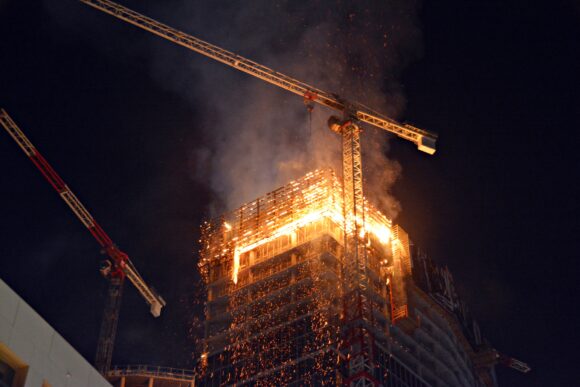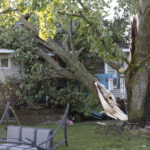Theft, fire and water damage are the top three claims for builders risk insurance. Here are examples of how they happen, and what insureds can do to mitigate the risks.
Long gone are the days when claims were more about vandalism than treachery, and when a damaged pipe or faulty fixture on a new structure was quickly repaired by a reputable crew that had been there, done that and knew you.
We are now in an era of uncertainty, fueled by a scarcity of materials, higher prices and under-qualified labor. Ever since COVID, entire drop-offs of lumber, siding and other valuable building materials have been disappearing en masse, sometimes within hours of delivery. Most likely, these are inside jobs. Additionally, inexperienced, indifferent or inattentive crews, often reduced in size due to labor shortages, are leaving sites with open windows, unchecked plumbing and paint- and varnish-soaked rags packed inside combustible containers.
Theft, which often involves vandalism, is the most prevalent claim, followed by water damage, fire and, more and more these days, weather. Hail, tornadoes and wind have caused havoc in areas where we’ve not historically expected them to occur.
Regardless of the cause, there are ways your course-of-construction clients can mitigate risks. Here’s a list of suggestions I’ve compiled from my experience supporting builders risk claims investigations.
1. Schedule deliveries — especially large ones — for the morning. Materials delivered late in the day, after the job site has been vacated, are at high risk of theft. If early drop-offs aren’t possible, conceal materials or position physical barriers to prevent unauthorized vehicles from accessing the site.
2. Leverage technology and surround the site with barriers. Pre-wire Wi-Fi when possible, and get electricity working, so alarms, cameras and lighting can be installed strategically. There are also portable, stand-alone security systems that provide 24/7 monitoring and could even eliminate the need for a full-time guard.
Additionally, physical barriers surrounding the site can provide a front-line defense to limit access or make it more difficult to steal large scale materials and equipment.
3. Check connections after plumbing is installed. Leaks from flawed hookups don’t always manifest immediately, so monitor newly connected fixtures throughout the day to ensure there are no little problems that can become crises overnight.
In cold weather, install heat before water is turned off or make sure water is drained from pipes before leaving the site.
Additionally, have equipment on hand to remove water immediately should an issue arise.
4. Store paint and stain rags in receptacles designed to prevent spontaneous combustion. These inexpensive containers, which range from six to 21 gallons, are available at building supply or big box stores such as Home Depot or Lowe’s. If using subcontractors, consider adding contract language that specifies use of these containers. Better yet, have subcontractors remove the rags from the job site each day.
5. Restrict smoking and guard against fire. It only takes one ember to create a blazing disaster. While it’s common, smoking should be prohibited near the job site, especially next to any debris pile.
Also, paint and stain rags (even if stored in appropriate receptacles) and other flammable materials should be kept away from kerosene- and propane-fueled portable heaters.
When cutting and welding are involved, have someone stay at least one hour after the workday ends to make sure there’s nothing smoldering after work has been completed.
In addition to these steps, clients should ensure fire extinguishers are strategically placed and workers know their location.
6. Close windows, be strategic about the roof installation and prepare for freezes. Contractors often don’t realize the amount of damage water can do, and how costly it is to repair.
Whether it enters through the roof or a broken pipe, there is the potential for extensive damage to flooring, baseboards and cabinets. In certain months, contractors should anticipate freezing temperatures by turning off water, draining pipes and turning on the heat.
On top of that, mold and mildew often follow water damage, which can delay a project longer and become more expensive to repair or restore. Agents should encourage clients to talk to the claims adjuster for advice to mitigate loss even further.
Incidents such as theft, fire and water damage could raise the cost to insure future projects. That’s because builders risk rates are based in part on the experience of past jobs. Counseling clients to diligently mitigate their risks will help them keep rates low while furthering a healthy and long-term relationship between you, your client and the insurance provider.
Topics Claims
Was this article valuable?
Here are more articles you may enjoy.



 State Insurance Legislators ‘Greatly Disturbed’ by Trump AI Regulation Order
State Insurance Legislators ‘Greatly Disturbed’ by Trump AI Regulation Order  One of Highest Property Claims Severity Recorded in Q3 on Low Volume, Says Verisk
One of Highest Property Claims Severity Recorded in Q3 on Low Volume, Says Verisk  Insurance Covers Settlement Paid by Stocks Instead of Money: Delaware High Court
Insurance Covers Settlement Paid by Stocks Instead of Money: Delaware High Court  North Carolina Sting Operation Alleges Roofer Damaged Shingles to File Claim
North Carolina Sting Operation Alleges Roofer Damaged Shingles to File Claim 



